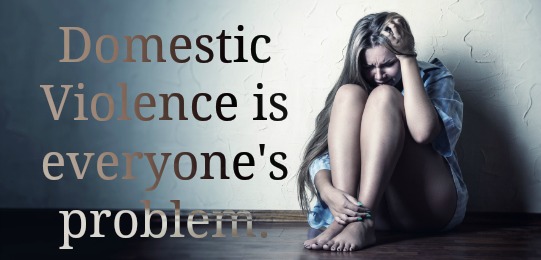
Why Doesn't She Just Leave? 5 Myths about Domestic Violence
It’s October, which means we’ll soon be swimming in a sea of pink — pink ribbons, pink t-shirts, and even pink football cleats — all to raise awareness about breast cancer.
But this month is also dedicated to another women’s issue, one that, in light of recent news in the NFL, is getting talked about far more than it ever has in the past: domestic violence.
The video of Baltimore Raven Ray Rice knocking his then-fiancee unconscious rocked many of us to our core. Not because we didn’t already know that domestic violence existed, but because the details of it are so unpleasant to think about. We shudder at the thought of a girlfriend covered in bruises or a wife trying to conceal a black eye.
While the video has gotten people talking openly about domestic violence in a way I haven’t seen before—which is a good thing!—it’s also brought to light many of the myths and misconceptions that continue to permeate our society’s collective understanding of this violent crime.
So today, in honor of Domestic Violence Awareness Month, I’m going to do my part to separate fact from fiction.

5 Common Myths About Domestic Violence
Myth #1: Domestic violence isn’t very common.
According to a 2010 survey by the CDC, about 1 in 4 women in the U.S. have experienced domestic violence.
Let that statistic sink in. A quarter of women in our country have been physically assaulted by a husband, boyfriend, or other intimate partner at some point in their lives.
What’s more, almost 3 out of 4 Americans personally know someone who is or has been a victim.
As a society, we flinch at the idea of scarred and bruised women; in reality, millions of women are wearing those scars and bruises every day.
Myth #2: Domestic violence only happens in low-income urban communities.
Tell that to my friend who volunteers at a domestic violence hotline, where she receives calls from all kinds of communities—urban, rural, suburban, all of them.
Domestic violence is a crime that is blind to demographic markers like income level, educational attainment, and geographic location. It can (and does) happen anywhere, to anyone—a fact that goes unrealized when it’s only talked about in hushed voices or under the breath, the way DV usually is.
Myths #3: Domestic violence is usually a one-time incident.
It’s actually quite the opposite.
Domestic violence is rarely limited to a single episode; it’s most often part of a clear pattern of abusive behavior—both physical and emotional—through which the abuser attempts to exert power and control over his partner.
Maybe he threatens her with violence if she doesn’t do what he wants, or perhaps he displays frightening fits of rage and jealousy if she so much as looks at another man.
Unfortunately many women who are victims tell themselves their partners will never hurt them again, but seldom does that hold true.
Myth #4: If it were that serious, she would just leave.
That statement is so easy to say from the outside looking in; from the inside looking out, it’s a totally different story—one that isn’t nearly so black and white.
What if the woman being abused doesn’t have a job, and therefore is financially dependent on the person hitting her?
What if she fears the violence will escalate if she attempts to get out (a very justified fear, considering that often an abused woman is in the most danger immediately after she leaves)?
What if she has children and doesn’t want to uproot their entire lives?
What if she genuinely cares about her partner and wants to believe he can change?
The fact that a woman feels a mixture of love and fear—that she’s torn between a desire to leave and a commitment to stay—is in no way an indication that the violence isn’t serious.
Myth #5: Domestic violence is a problem to be solved by women.
Victims of DV can be any gender, but the overwhelming majority (85%) are female.
If the responsibility to prevent such violence lies solely with the group that is suffering the abuse, we will inevitably hit a brick wall. Those who are at fault—male perpetrators—won’t be reached.
To create a safer world for women, well-meaning men—those who don’t shove their wives around, those who would never threaten their girlfriends—need to become actively engaged in the movement to end violence against women.
They need to stand side-by-side with the mothers, sisters, wives, and daughters they love to say that it’s time to start taking real action against domestic violence.
Did you know October is Domestic Violence Awareness Month? Want to get involved? Share this post, it could save a life!
If you think you are in danger, call the National Domestic Violence Hotline at 1-800-799-SAFE.
Victims of domestic violence are not limited to women; men can be victims as well. But because women account for an overwhelming majority of victims (85%), I feel it is appropriate to discuss domestic violence as a women’s issue.
Katie Markey McLaughlin is a freelance writer and blogger who believes that moms can do anything, but not everything. Her blog Pick Any Two encourages all of us to set priorities without apology or guilt. You can follow her on Facebook, Twitter, Pinterest, and Instagram.